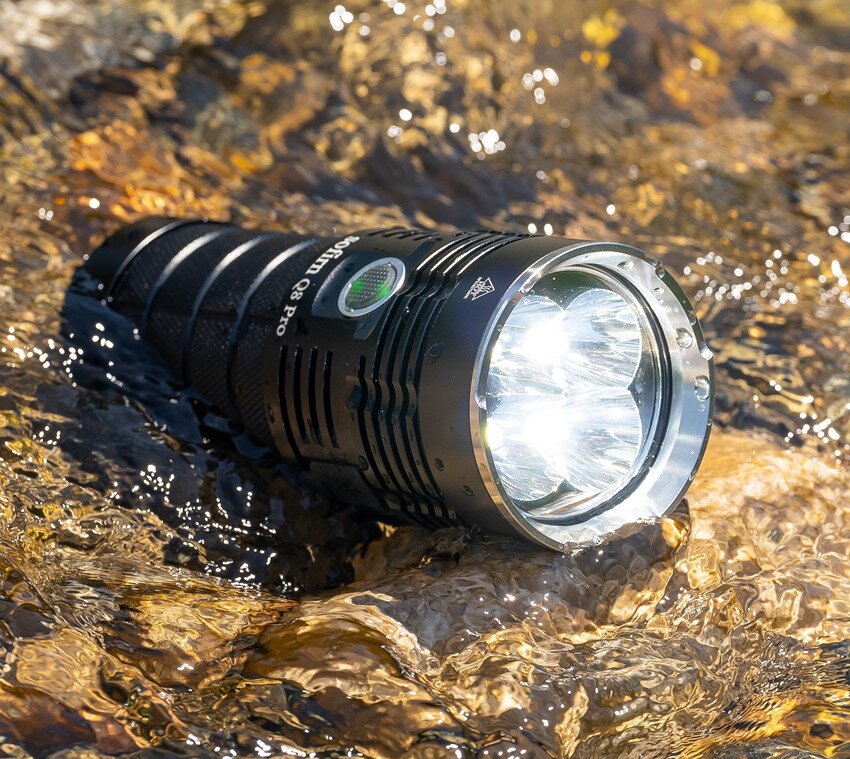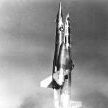Introduction
There are not many occasions in my every day life where I need more than an EDC sized torch, but there is always some excitement and a smile when wielding a torch of larger proportions and ridiculously high output.
Today is such an occasion, so with some excitement - and a smile - I present to you the most powerful torch Sofirn has to offer: The Sofirn Q8 Pro.

The Sofirn Q8 Pro is a soda can type torch which promises high output, long run times, a good user interface and other interesting features, all at a very affordable price. Let's put that to the test, shall we?
Unboxing
The Sofirn Q8 Pro comes in the usual unassuming, generic brown cardboard box that Sofirn likes to use. If it keeps the cost down, I am all for it. Only, in this case, there are two boxes.

Inside one of them, we find the torch, protected in bubble wrap, a 1 meter long USB A to USB C charging cable, 2 spare O-rings for the battery tube and 1 spare O-Ring for the bezel, a spare button cover and the manual. The other box contains the optional holster and diffuser, found on the company's website but not offered on Amazon.co.uk at the moment.


The torch comes with a little tag, secured around the body with a rubber band. The tag explains that there is an insulator in the battery compartment, stopping the batteries from making contact and thus rendering the torch inoperable, for safe shipping. The insulator needs to be removed before the torch can be used.


The Sofirn Q8 Pro is a black, cylindrical light, 132mm long and with a diameter of about 59mm at its widest point, which is the front bezel. The body features knurling which allows for a secure grip without being too aggressive. The button is rubbery, textured and slightly raised, so it is easy to find by touch, but can also be pressed while in a backpack or in a (very large) pocket. Thankfully, there is a lock out option to cover that contingency. The area around the button has some heatsinking in the form of fins, while at 90 degrees to its right there is a rubber flap.


Lifting the flap, reveals the USB C charging port.

Another 90 degrees to the right, at the exact opposite side of the button, we find a standard 1/4" threaded hole that allows the torch to be mounted on a tripod.



Beauty is in the eye of the beholder so I will not presume to tell you if the Sofirn Q8 Pro looks good or not, but I can definitely say that it is an elegant and unassuming design that seems to mean business.


That is even more true about the business end of the light, which features a quadruple orange peel reflector with deep enough cups to add a bit of throw. The emitters at the bottom of those cups are 4 Cree XHP50.2 6500K LEDs.


The battery compartment can be accessed by unscrewing the light into two halves and contains 4 batteries. The front side has an insulator covering which must be removed to reveal the circular battery contacts.


The threads are square cut, come pre-greased and operate smoothly.

The batteries are Sofirn branded 18650 Li-Ion and rated at 3000mAh.

The inner circular battery contact is for the positive contacts of the 4 batteries while the outer circular battery contact gets the negative via the metal body of the battery compartment. The metal body of the battery compartment gets the negative from the batteries through 4 thick double springs at its bottom. The thickness of the springs, the fact that they are double and the whole design seems capable of transferring the power of the batteries to the driver with minimal losses. It is also easy to mechanically lock out the torch by unscrewing the battery compartment by half a turn, thus breaking the contact between its non anodized lip of the battery compartment and the outer circular contact of the head.


The driver is secured with 2 screws, which can be removed to access its other side. There, we see 2 black and 2 red cables, that transfer the current from the driver to the emitters. I am not sure why double cabling was preferred to using a bigger gauge cable, but it certainly will help to transfer power with less resistance. The 5 white cables are for the switch and its indicative LEDs.
There are no programming pads on the outer side of the driver to update the firmware of the ATTiny85 chip that controls the torch, but the easy access to the inner side means that the same can be accomplished with a SOIC clip directly on the chip.

With the insulator out of the way, the Sofirn Q8 Pro s ready for action, which is indicated by the 2 green LEDs on the switch.

The diffuser is plastic and fits on top of the torch when it tail stands, but is loose and will fall if the torch is lifted up and tilted. It can also break if it is dropped. I would definitely prefer a silicone diffuser.

The holster is adequate and closes securely via a hook and loop stripe at the front. It is functional but I would prefer it if it was made from a thicker material.


The back features both a sewn belt loop, as the most secure option and another that is secured via hook and loop, to allow fastening the holster to a belt without unfastening the belt. The holster also features a plastic D ring.

Quality
The build quality of the Sofirn Q8 Pro is very good and on par with other Sofirn lights.


The fit and finish are excellent, the knurling is of good quality and the anodization is without any flaws. The addition of a stainless steel bezel is welcome and adds protection and aesthetics.
Specifications
The specifications of the Sofirn Q8 Pro, as found on the company's website, are as follows:

The torch features 4 Cree XHP50.2 emitters with a CCT of 6500K (cool white - there is also a neutral white version at 5000K) which provide a maximum output of 11000 Lumen and a maximum throw of 400m. It is powered by 4x 3000mAh 18650 Li-Ion batteries, is USB C rechargeable and incorporates a power bank function.

The Sofirn Q8 Pro is made of aluminium and is 134mm long and 59mm wide at the bezel. The weight without the batteries is approximately 408g (I measured 418g without the batteries and 604g with the batteries).

The Sofirn Q8 Pro is water proof rated equivalent to IPX8.

User Interface
The user interface of the Sofirn Q8 Pro is a love or hate deal, as the light features the Andúril2 UI. Personally, I love it and deeply enjoy the fact that it is feature packed but still provides simple, quick and intuitive access to the basic functions. Others hate it and consider it too much work, as the manual is extensive and even the flow chart found at the company's website can be intimidating to look at.
Andúril2 offers a Simple UI, which the torch comes set to, that allows for all the basic functions, while remaining relatively simple.

10 clicks and hold the last, and you enter the magical realm of the full Andúril2 experience. Give it a chance! You will love it!

In my experience, after the initial shock, it is very easy to start using Andúril2 and have an occasional look at the flow chart to remind oneself of the more advanced functions.
An important thing to do when you take any Andúril2 light out of the box is to perform a temperature calibration, as the light will depend on it to perform proper thermal control and balance brightness with temperature. That is also the best time to set the temperature limit. I find 50°C to be a good temperature limit and the tests done in this review were done on a calibrated light and with a 50°C temperature limit.
Size Comparison
The following photos offer a direct size comparison of the Sofirn Q8 Pro to the Olight X7R. the Sofirn Q8 Pro is slightly longer but has a smaller diameter at the head.



Tint and Beam Shots
The tint of the Sofirn Q8 Pro is the cool, greenish (above BBL) tint that is expected of the Cree XHP50.2 emitters. It is very similar to the tint of the Olight X7R. The XHP50.2 used in the Sofirn Q8 Pro are not high CRI.
We can also see from the angle of the beams that the Olight X7R has a floodier beam pattern than the Sofirn Q8 Pro.

The beam pattern of the Sofirn Q8 Pro is a product of the LED type and size and the reflector it uses. With the 5x5mm Cree XHP50.2 emitters and orange peel reflector, it is not surprising that the result is a floody beam but the depth of the reflector cups adds some throw.
There is a wide hot spot surrounded by a corona ring and a smooth flood of light.

I tested the Sofirn Q8 Pro over a distance of 70m.

The following video shows a comparison of the Sofirn Q8 Pro to the Olight X7R.
Driver
The driver of the Sofirn Q8 Pro is a linear, unregulated driver that uses PWM to dim the light, on all levels, except, of course, on full. The PWM is visible to the camera but not visible to the naked eye, on any level.

Even though I prefer constant current drivers, PWM is an efficient and cost effective way to achieve LED dimming and if it is done at a high enough frequency, as seems to be the case here, it is not a problem. The driver features thermal regulation, low voltage protection and reverse polarity protection.
Current Draw
The lowest setting of the Sofirn Q8 Pro (floor of the ramp) only draws 3mA. The top of the ramp draws 8.03A and Turbo requires 22.4A.

You can run the Sofirn Q8 Pro with all 4 batteries or with 3 or 2 or even 1 battery. Each of the batteries provided with the Sofirn Q8 Pro can output up to 10A (tested) so in order to get full brightness on Turbo you need to use at least 3 batteries. All measurements were taken with all 4 batteries in the torch.
Charging
The batteries included with the Sofirn Q8 Pro are rated at 3000mAh and I measured them to be right around that number (2953mAh / 3016mAh / 3032mAh / 2997mAh) The torch has under voltage protection and turns off when the battery voltage drops to 2.9V. The batteries' internal resistance was measured at around 50mΩ (50mΩ / 53mΩ / 54mΩ / 40mΩ). It is clear that the batteries included with the Sofirn Q8 Pro are of high quality.

Charging the Sofirn Q8 Pro is very easy. Just lift the rubber cover and connect the provided cable or any other USB C cable to the charging port and its other end to a charger. Both USB A to USB C and USB C to USB C cables can be used as well as any charger, including the ones that support PD. This is very convenient as you can charge the Sofirn Q8 Pro with any USB C cable and charger you have at hand.

The blue indicative LEDs on the switch blink while the light is charging and stay steadily on when the charging is completed, at 4.19V.

Charging the Sofirn Q8 Pro from 2.9V to 4.19V took 4 hours, 51 minutes and 7 seconds. The maximum current drawn was 2.8385A, so a charger that can provide at least 3A is recommended to achieve the fastest charging speed. A charger is not provided with the light but you can use your phone charger.

Power Bank Function
A very nice feature of the Sofirn Q8 Pro is its ability to function as a power bank. When the power bank function is in effect, the red indicative LEDs turn on.

There is no information available regarding the current that the power bank function can provide through the USB C port so I had to investigate. I found that the Sofirn Q8 Pro can provide a maximum steady output of 3A for 2 hours, 19 minutes and 19 seconds. The output is very stable and the end of the test the voltage of the batteries was 3.15V.

The power bank function provided a total of 34.8759Wh while discharging the batteries from 4.19V to 3.15V. Charging the batteries from 2.9V to 4.19V requires, as we saw in the previous section, 48.9621Wh. This means that the power bank function has a efficiency of over 71%, without even taking into account that there is still some energy remaining in the batteries as the power bank function stops when their voltage drops to 3.15V and they can still be discharged to 2.9V by using the torch.
Output & Runtimes
The Sofirn Q8 Pro is rated at 11000 Lumen output and 400m of throw.
I do not own a multi thousand dollar worth integrating sphere, just a logging Lumen meter and a home made integrating tube. The array is calibrated with 3 separate, professionally measured lights and gives me consistent results, but there is definitely room for error and deviations are to be expected.
According to my measurements, the maximum output (at turn on) was an impressive 14310 lumen, which is 30% more than the advertised 11000! ANSI output (at 30 seconds) was 13365 Lumen and 45 seconds it was still 13320 Lumen. Then the output declined steadily to 8859 Lumen at 1 minute, 4396 Lumen at 1.5 minutes and 2277 Lumen at 2 minutes. It remained at that level until 00:05:45 and then dropped to 1359 Lumen.
The rest can be seen in the graphs below. The first graph is the full runtime graph that my equipment can record with a sampling interval of 5 seconds. At 29 hours, 9 minutes and 55 seconds, the Sofirn Q8 Pro was still on, with an output of 0.5 Lumen.

Most of the action happens in the first 5 hours though, so here is a graph that shows that part of the runtime in greater detail.

And here are the first 10 minutes.

The temperature was very well controlled, as you can see in the runtime graphs. The head and body temperatures are very close, which shows the excellent thermal conductivity of the torch.
The torch was temperature calibrated, according to the manual, and the temperature limit was set at 50C. The actual temperatures near the button and on the body of the torch can be seen on the graphs and were kept well within the set limit.
All in all, the Sofirn Q8 Pro gave outputs of over 1000 Lumen for over 3 hours and 40 minutes, when turned on at Turbo, which is very respectable, especially considering the very high initial output. Usage at more moderate levels, will of course, result in higher runtimes.
The maximum intensity of the light was measured at 52241cd, which translates to a throw of 457m. That is 14.25% more than the 400m advertised.
Conclusion
The Sofirn Q8 Pro is a value for money, soda can sized torch that will not disappoint. Its aluminium body is well made and hard anodized and the fit and finish is beyond its price point.
The size and weight are good for its output rating and the 4 provided 3000mAh 18650 batteries allow for ample runtime. The maximum measured output of 14310 Lumen is 30% over the advertised 11000 Lumen, which is very impressive, and the beam profile is well balanced.
The tint of the Cree XHP50.2 LEDs is a cool, above BBL (greenish) tint and the CRI is low, but this is countered by the high lumen output these emitters allow the torch to achieve.
The driver is linear (unregulated) and uses PWM to dim the output, so PWM is present at all output levels, except on Turbo. The frequency of the PWM is high enough to not be visible to the naked eye and did not tire me when using the light.

The Sofirn Q8 Pro can be purchased from Amazon.co.uk in a kit with the batteries but not with the diffuser and holster and the cost at the moment this review is written is £89.99. Sofirn have provided a 30% discount code for the readers of this review, which brings the price down to £62.99. That is a very competitive price for a torch that can provide over 14000 Lumen and incorporates USB C charging and a power bank function at 3A.
The discount code is: polymeros30
For the rest of the world, the Sofirn Q8 Pro can be purchased directly from the Sofirn website on its own, as a kit with the batteries or as a kit including the batteries, diffuser and holster.
Disclaimer: I get absolutely no percentage of the sales or any other personal benefits from Sofirn, except for the fact that the torch was provided for review free of charge.
Let's list the Pros and Cons of the Sofirn Q8 Pro:

Pros
+ Value for money
+ Maximum output of 14310 Lumen (of 11000 advertised)
+ Maximum throw of 457m (of 400m advertised)
+ Power bank function at 3A with good efficiency
+ USB type C charging at 3A
+ Aluminium Alloy construction with good fit and finish
+ Low Voltage Protection which turns off the torch when the battery voltage drops to 2.9V which preserves the health of the batteries
+ Thermal regulation
+ Well balanced beam
+ 4x 18650 Li-Ion 3000mAh (actually measured) high quality batteries included
+ Low power, charging and power bank function indicator LEDs on the switch
+ Andúril2 UI
+ Lighted button with indicative LEDs
+ IP68
+ Compatible with all button top 18650 batteries
+ A diffuser and a holster can be purchased from the company's website at low cost

Cons
- The driver is not regulated and uses PWM to dim the emitter
- The quality of the optional holster could be better
- The optional diffuser is made of plastic while a silicone diffuser would be better
Thanks to Sofirn for providing the torch for review
Polymeros Achaniotis 01/10/2021
-
 7
7
-
 1
1













Recommended Comments
Create an account or sign in to comment
You need to be a member in order to leave a comment
Create an account
Sign up for a new account in our community. It's easy!
Register a new accountSign in
Already have an account? Sign in here.
Sign In Now